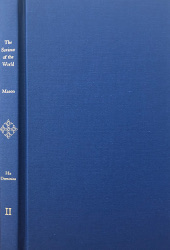The Saviour of the World II: His Dominion

Author:
Charlotte M. Mason
Publication:
1908 by Kegan Paul, Trench, Trübner, & Co. Ltd. (London)
Genre:
Bible Stories, Devotionals & Spiritual Growth, Poetry
Series:
The Saviour of the World by Charlotte Mason ![]() Members Only
Members Only
Series Number: 2
Pages:
186
Current state:
This book has been evaluated and information added. It has not been read and content considerations may not be complete.
Book Guide
Search for this book used on:
The idea, which appears to be gradually developed in that portion of the Gospel history dealt with in the first volume of this work, is embodied in the memorable declaration of the men of Samaria—this is indeed the Saviour of the World— with which The Holy Infancy closes.
That "He is Lord of all," the dominion, supremacy, the universal authority of our Lord appears to be the salient idea in this second volume. A careful study of the section here paraphrased leaves the reader convinced that the Authority of our Lord was that attribute by which the Jews were during this period of the Ministry (between the first and second Passover) most profoundly impressed: and it may not be unprofitable to bear this fact in mind at a time when our conception of Christianity is lowered through a tendency to disregard the Authority of our Head.
The writer ventures to repeat some of the remarks which prefaced The Holy Infancy, adding this further plea for a rendering of the Gospel History in verse— that possibly the incomparableness of our Lord's Personality and Teaching could not be better exhibited than by even a feeble paraphrase (in verse) of the records we possess in the Gospels. Any life and teaching less than divine would shrink into insignificance if every recorded incident and saying were subjected to such treatment...
...It seems to the writer that verse offers a comparatively new medium in which to present the great theme...
...The scope of this work, The Saviour of the World, is to cover each incident and each saying in a single poem, blank verse or rhymed stanza, according to the subject. The poems follow one another in a time sequence, but each is distinct and separable. Therefore, though the work will, God willing, continue through a series of little Christmas volumes (probably eight), each volume will be complete in itself and independent of the rest.
Excerpts from the Introduction
To view an example page please sign in.
Find This Book
Search for this book used on:



